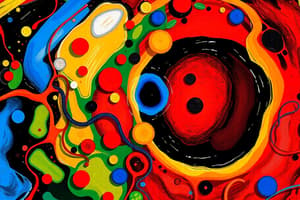Podcast
Questions and Answers
What are the two major parts of a typical cell?
What are the two major parts of a typical cell?
- Nucleus and endoplasmic reticulum
- Nucleus and cytoplasm (correct)
- Nucleus and mitochondria
- Mitochondria and cytoplasm
What separates the nucleus from the cytoplasm?
What separates the nucleus from the cytoplasm?
- Cell membrane
- Endoplasmic reticulum
- Mitochondria
- Nuclear membrane (correct)
Which of the following substances is NOT a component of protoplasm?
Which of the following substances is NOT a component of protoplasm?
- Water
- Proteins
- Electrolytes
- Nucleic acids (correct)
What is the principal fluid medium of the cell?
What is the principal fluid medium of the cell?
Where do chemical reactions take place within the cell?
Where do chemical reactions take place within the cell?
What separates the cytoplasm from the surrounding fluids?
What separates the cytoplasm from the surrounding fluids?
In what concentration is water present in most cells?
In what concentration is water present in most cells?
What is the term for the different substances that make up the cell?
What is the term for the different substances that make up the cell?
Which part of a typical cell is separated from the cytoplasm by a nuclear membrane?
Which part of a typical cell is separated from the cytoplasm by a nuclear membrane?
In what concentration is water present in most cells, except for fat cells?
In what concentration is water present in most cells, except for fat cells?
Which component of protoplasm is mainly responsible for the principal fluid medium of the cell?
Which component of protoplasm is mainly responsible for the principal fluid medium of the cell?
Where do chemical reactions mainly take place within a cell?
Where do chemical reactions mainly take place within a cell?
Which part of a cell is also known as the plasma membrane?
Which part of a cell is also known as the plasma membrane?
Flashcards are hidden until you start studying
Study Notes
Cell Structure
- A typical cell has two major parts: the nucleus and the cytoplasm.
- The nucleus is separated from the cytoplasm by a nuclear membrane.
- The cytoplasm is separated from the surrounding fluids by a cell membrane (also called the plasma membrane).
Composition of Protoplasm
- Protoplasm is the collective term for the substances that make up the cell.
- Protoplasm is composed mainly of five basic substances: water, electrolytes, proteins, lipids, and carbohydrates.
Properties of Water in Cells
- Water is the principal fluid medium of the cell.
- Water is present in most cells, except for fat cells, in a concentration of 70 to 85 percent.
- Many cellular chemicals are dissolved in the water.
- Others are suspended in the water as solid particulates.
- Chemical reactions occur among the dissolved chemicals or at the surfaces of the suspended particles or membranes.
Cell Survival
- Each of the 100 trillion cells in a human being is a living structure that can survive for months or many years.
- Cell survival depends on the surrounding fluids containing appropriate nutrients.
Studying That Suits You
Use AI to generate personalized quizzes and flashcards to suit your learning preferences.




